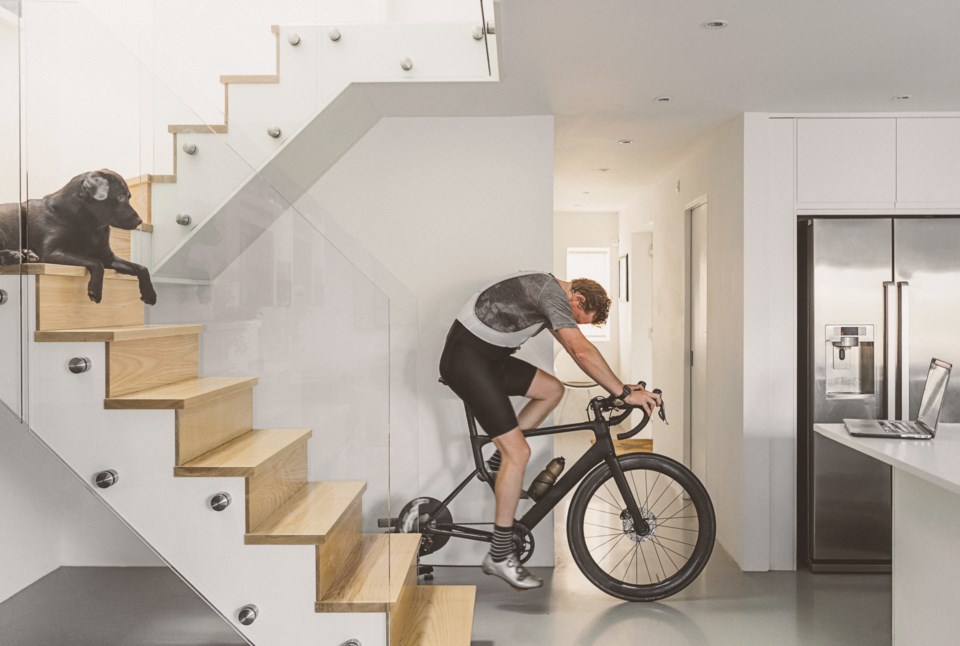I don’t know about you, but I’ve never been a fan of the gym. Even before COVID-19 shut down most of the gymnasiums in the world, my few attempts to make it a routine over the years never lasted more than a couple of months and would barely qualify as a fad. I just found it so damn boring.
Gyms have their uses, of course. High-performance athletes need somewhere to train properly, and not everyone has space to safely perform a deadlift in their living room or non-existent garage. But the equipment I always found the most pointless was the cardio machine: Treadmills, trainer bikes and elliptical machines. I get that it’s not always ideal running weather outside, but I’d rather run in the rain with my dog than spend a half hour turning a hamster wheel.
Summer in Whistler should give people every excuse to exercise their cardio outside instead of inside. Ride bikes, run the trails, paddle across the lakes, whatever gets you fresh air and raises your heart rate. In the winter, however, cardio becomes a bit trickier. I’ve dabbled in Nordic skiing and actually enjoyed it, but with pineapple storms always looming around the corner, it’s far from a weatherproof activity. Ski touring is my jam, but again, it’s both weather and snowpack dependent and requires a full day of commitment if you really want to get somewhere awesome.
What I began to notice in the last few years as my work transitioned to an indoor/office affair, was that my long winters were not giving me the exercise outlet that I needed to keep my body (and my mind) operating at peak efficiency. I could still do big days of ski touring, but my recovery was slow. Spring skiing and touring never really prepared my body for a Whistler mountain bike season. Ever resistant to the idea of a gym membership, I decided to join a group of my cycling friends on Zwift.
For those not familiar, Zwift is a virtual cycling tool that works much like an online video game. You can log in to servers and ride around with random people from all over the world, join ride/race events or embark on a private ride just with you and your friends. To achieve the desired simulation, Zwift requires that you have a bike connected to a smart trainer, which sends your power output data via Bluetooth to your display device such as a tablet, TV or laptop. The smart trainer can increase pedal resistance (to a certain degree) if you decide you want to tackle a hill climb stage of the Tour de France, for example.
With the meteoric growth of home workout equipment in 2020, both smart trainers and bikes have been in short supply and high demand. I managed to find a rare second hand Wahoo Kickr Snap smart trainer on the Vancouver Buy & Sell for $600, which is about the minimum you can expect to spend on a used unit. Good, cheap, used road bikes are also quite rare, so I ended up blowing that budget a bit with an older model Cannondale Synapse in excellent shape for $900. Add in the Zwift monthly membership of $18 and you can see that this is by no means a small investment. That said, my indoor cycling setup was the best money I’ve spent on sport equipment in years. Here are a few reasons why.
I now have a training tool that I can use in any weather, any time of the day when I have 30 to 60 minutes to spare to spin the cranks.
I can nerd out to my heart’s content about stats. After a couple of weeks of Zwifting I picked up a heart rate monitor for the first time in my life just so I could benchmark my hardest training sessions.
When work dictates that I have to miss that bluebird backcountry mission or powder day, I can grind out my frustration on the trainer and feel better almost immediately.
I don’t race anymore, but I’ve never felt more prepared for the biggest days of the mountain bike season.
I can now conveniently earn my beer without going out into the rain, cold or darkness of winter.
I won’t get into the nitty gritty of a buying guide here, as that content is ubiquitous on the internet. But if you’re considering an indoor cycling trainer, here’s a few helpful things I learned.
• Wheel-on versus direct-drive: The direct-drive units are the most accurate of the smart trainers but can cost up to twice as much. Wheel-on does the job just fine if you’re not training for races or actual road-bike events.
• Any bike will work with a smart trainer, but the gearing and geometry of a road bike are the best. Keep that drivetrain tuned up and lubricated.
• Zwift is just one of many competitive online cycling platforms, but it’s heralded as the best for the social community and gamifying the indoor-cycling experience. If you’re more into pure stats consider TrainerRoad.
• Make sure your space is set up appropriately. You need a somewhat powerful fan to avoid dripping sweat constantly and an open window helps too.
• Smart trainers are a lot quieter than the fan-resist exercise bikes of yore, but you probably shouldn’t be training while others in your house or building are sleeping.
• You may already be riding your bike outside, and that’s great. But if you’re considering a smart trainer setup for next winter, the summer is the best time to shop, especially on the secondhand market. Spin to win.
Vince Shuley is considering biking, now that it’s April. For questions, comments or suggestions for The Outsider email [email protected] or Instagram @whis_vince.




